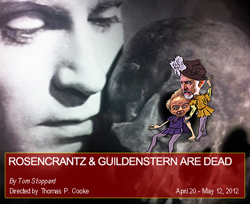THE TRIUMPH OF IRONY
When Tom Stoppard’s play Rosencrantz and Guildenstern are Dead (R&G) premiered at the Edinburgh Festival in 1966, the critics hated it. While a poor production may have been partially to blame, the ensuing decades have certainly vindicated him. Stoppard’s talent for reworking Shakespeare earned him a 1999 Oscar for Shakespeare in Love.
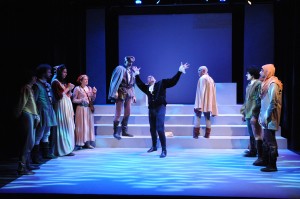 In contemporary parlance, R&G could be considered fan fiction: Stoppard borrows all of his play’s characters from Shakespeare’s Hamlet, yet he doesn’t stop there. Not only the play’s title, but nearly every scene in Hamlet involving R&G is copied verbatim and used as the basis of his own oddball tale. For those needing a refresher, Rosencrantz and Guildenstern are companions of Hamlet’s youth who are summoned to Elsinore by Claudius and Gertrude, King and Queen of Denmark, to ascertain the “cause of Hamlet’s lunacy.” They are minor characters and contribute little to the action of Shakespeare’s play, serving primarily as a means for conveying the state of Hamlet’s mind to the audience. They come across as rather foolish characters or, at least, unsuccessful ones, since they neither achieve the purpose of their summons nor do they live to tell of it.
In contemporary parlance, R&G could be considered fan fiction: Stoppard borrows all of his play’s characters from Shakespeare’s Hamlet, yet he doesn’t stop there. Not only the play’s title, but nearly every scene in Hamlet involving R&G is copied verbatim and used as the basis of his own oddball tale. For those needing a refresher, Rosencrantz and Guildenstern are companions of Hamlet’s youth who are summoned to Elsinore by Claudius and Gertrude, King and Queen of Denmark, to ascertain the “cause of Hamlet’s lunacy.” They are minor characters and contribute little to the action of Shakespeare’s play, serving primarily as a means for conveying the state of Hamlet’s mind to the audience. They come across as rather foolish characters or, at least, unsuccessful ones, since they neither achieve the purpose of their summons nor do they live to tell of it.
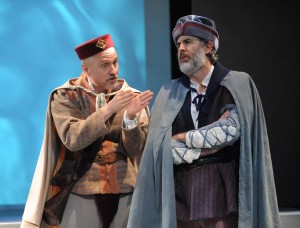 Stoppard’s play is written in three acts, each of which interweaves scenes directly from Hamlet. In the first act, the two title characters travel to Elsinore, meeting The Player and his Tragedian along the way. The second act follows the principal action of Hamlet at Elsinore. Finally, in the third act, Stoppard imagines what could have happened on the ship to England, which Hamlet only alludes to. Stoppard unusually does not change the story of Hamlet, but adapts it and works within its limitations. In doing so, he shows that R&G lack free will and are powerless to change the narrative of which they are a part. This is highlighted by the opening scene where Rosencrantz (Craig Anton) or Guildenstern (John Prosky) are tossing coins and, against all probability, each one comes up heads. Later on, when the two are seeking Hamlet, they first go one way, then another, split up and come back together, without ever going anywhere, until Hamlet finally comes to them. It all comes across as rather absurd, but incredibly droll.
Stoppard’s play is written in three acts, each of which interweaves scenes directly from Hamlet. In the first act, the two title characters travel to Elsinore, meeting The Player and his Tragedian along the way. The second act follows the principal action of Hamlet at Elsinore. Finally, in the third act, Stoppard imagines what could have happened on the ship to England, which Hamlet only alludes to. Stoppard unusually does not change the story of Hamlet, but adapts it and works within its limitations. In doing so, he shows that R&G lack free will and are powerless to change the narrative of which they are a part. This is highlighted by the opening scene where Rosencrantz (Craig Anton) or Guildenstern (John Prosky) are tossing coins and, against all probability, each one comes up heads. Later on, when the two are seeking Hamlet, they first go one way, then another, split up and come back together, without ever going anywhere, until Hamlet finally comes to them. It all comes across as rather absurd, but incredibly droll.
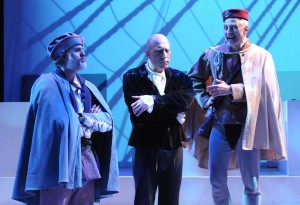 California Repertory’s new production of R&G, directed by Thomas P. Cooke, is a highly professional production that is whimsical and purposefully amateurish in its approach, reminding this reviewer of Monty Python and the Holy Grail in its comic take on the Middle Ages. The costumes, designed by Vivianne Pilon-Toppings, do not strive for realism, but with their colorful hosiery and prominent codpieces, manage to convey the play’s medieval setting. One of the title characters, either Rosencrantz or Guildenstern, even looks a bit like John Cleese, with his tall lanky figure and goofy grin (it is difficult to remember who is who, since Stoppard continually mixes them up).
California Repertory’s new production of R&G, directed by Thomas P. Cooke, is a highly professional production that is whimsical and purposefully amateurish in its approach, reminding this reviewer of Monty Python and the Holy Grail in its comic take on the Middle Ages. The costumes, designed by Vivianne Pilon-Toppings, do not strive for realism, but with their colorful hosiery and prominent codpieces, manage to convey the play’s medieval setting. One of the title characters, either Rosencrantz or Guildenstern, even looks a bit like John Cleese, with his tall lanky figure and goofy grin (it is difficult to remember who is who, since Stoppard continually mixes them up).
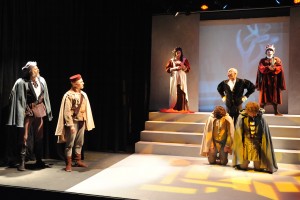 Cooke’s production truly shines with innovation in its use of multimedia. When the lights dimmed in the theatre, the opening credits of the black-and-white film version of Hamlet (1948), starring Laurence Olivier, began to roll. Then, on the screen, Anton and Prosky appear, spliced into the film, shortly before walking on stage and beginning the play as Stoppard wrote it. Further scenes from the film, particularly the dramatic and moody ones, are interwoven into the play’s action, some in place of the Hamlet scenes that Stoppard borrows, some in addition to them, pointing up the comedy and absurdity of R&G. Through the use of this film, Stoppard’s characters are not only caught up in Shakespeare’s plot on stage, but also on screen, thereby adding a further layer to the pre-determined destinies of The Bard’s characters.
Cooke’s production truly shines with innovation in its use of multimedia. When the lights dimmed in the theatre, the opening credits of the black-and-white film version of Hamlet (1948), starring Laurence Olivier, began to roll. Then, on the screen, Anton and Prosky appear, spliced into the film, shortly before walking on stage and beginning the play as Stoppard wrote it. Further scenes from the film, particularly the dramatic and moody ones, are interwoven into the play’s action, some in place of the Hamlet scenes that Stoppard borrows, some in addition to them, pointing up the comedy and absurdity of R&G. Through the use of this film, Stoppard’s characters are not only caught up in Shakespeare’s plot on stage, but also on screen, thereby adding a further layer to the pre-determined destinies of The Bard’s characters.
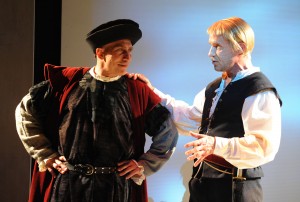 Performing at the Royal Theatre aboard the Queen Mary makes for an interesting viewing experience. Whereas Stoppard’s English audience would have particularly enjoyed the irony of Rosencrantz saying that he didn’t believe in the existence of England, the Long Beach audience can laugh at the irony of Rosencrantz’s question, “Do you think death could possibly be a boat?” Anton and Prosky make for an amusing double act, but it is Robert Prior as The Player who steals their scenes whenever he appears. Leading his players with the camp and charisma of a revivalist preacher, he both delights and disgusts.
Performing at the Royal Theatre aboard the Queen Mary makes for an interesting viewing experience. Whereas Stoppard’s English audience would have particularly enjoyed the irony of Rosencrantz saying that he didn’t believe in the existence of England, the Long Beach audience can laugh at the irony of Rosencrantz’s question, “Do you think death could possibly be a boat?” Anton and Prosky make for an amusing double act, but it is Robert Prior as The Player who steals their scenes whenever he appears. Leading his players with the camp and charisma of a revivalist preacher, he both delights and disgusts.
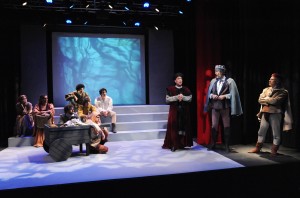 The curtain never goes down in this revival; actors simply exit and enter from the wings, which suits the script flawlessly. In Stoppard’s play, scenes continually switch in and out from those of his own creation to those of Shakespeare’s Hamlet. It’s a true work of art. Cal Rep has remained faithful to Stoppard’s vision even while giving it their own interpretation, one that is both creative and original.
The curtain never goes down in this revival; actors simply exit and enter from the wings, which suits the script flawlessly. In Stoppard’s play, scenes continually switch in and out from those of his own creation to those of Shakespeare’s Hamlet. It’s a true work of art. Cal Rep has remained faithful to Stoppard’s vision even while giving it their own interpretation, one that is both creative and original.
Photos by Keith Ian Polakaff
Rosencrantz and Guildenstern are Dead
California Repertory at the Royal Theatre aboard the Queen Mary in Long Beach (Los Angeles Theater)
scheduled to end on May 12
for tickets, visit http://www.calrep.org
